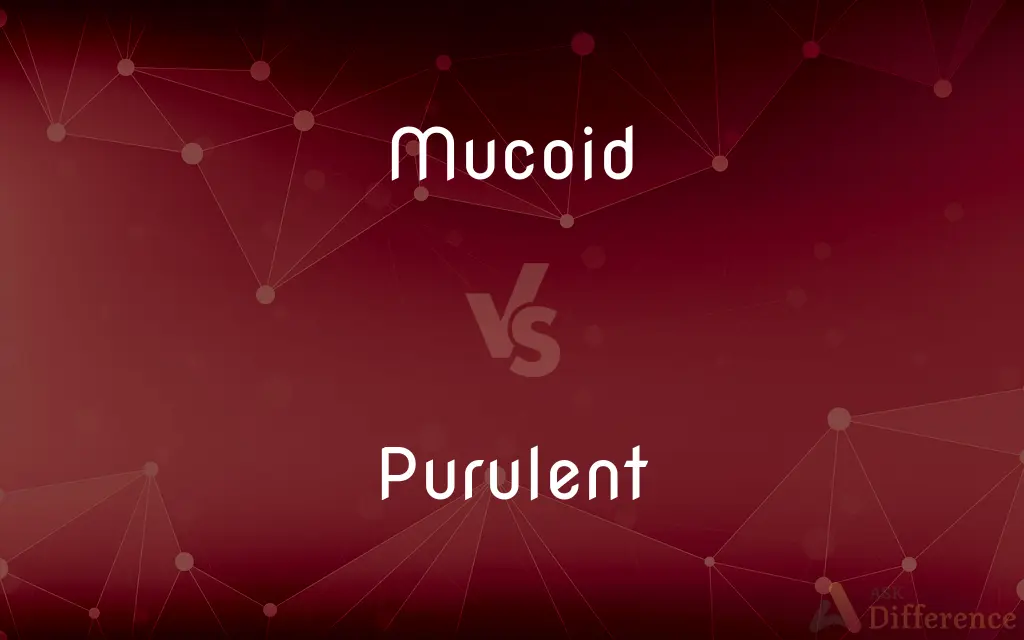Mucoid vs. Purulent — What's the Difference?
By Urooj Arif & Maham Liaqat — Updated on April 5, 2024
Mucoid refers to a clear, slimy substance resembling mucus, often found in normal secretions, while purulent describes pus-filled, often indicating infection or inflammation.

Difference Between Mucoid and Purulent
Table of Contents
ADVERTISEMENT
Key Differences
Mucoid secretions are typically clear, slimy, and resemble mucus, which is a natural protective lubricant produced by the body's mucous membranes. These secretions play a crucial role in trapping pathogens, dust, and other foreign particles, facilitating their removal from the body. On the other hand, purulent secretions are characterized by their yellowish or greenish color and their pus-filled composition, indicating the presence of infection, inflammation, or both. Pus is a mixture of dead white blood cells, bacteria, and tissue debris.
In the context of respiratory health, mucoid sputum is often a sign of normal respiratory function or mild irritation. It can be produced in larger quantities in response to allergens, irritants, or colds. Conversely, purulent sputum is typically associated with bacterial infections, such as bronchitis or pneumonia, and signals a more serious health issue requiring medical attention. The presence of purulent secretions often necessitates antibiotic treatment.
When evaluating wound healing, mucoid discharge can be a part of the normal healing process, acting as a protective barrier and facilitating cell migration and tissue repair. In contrast, purulent discharge from a wound is a clear indicator of infection, necessitating immediate medical intervention to prevent further complications. It often requires cleaning, drainage, and possibly antibiotics.
The consistency and appearance of secretions can also provide valuable diagnostic clues in ophthalmology. Mucoid discharge from the eye can be a sign of dry eye syndrome or mild irritation, while purulent discharge often points to bacterial conjunctivitis or keratitis, conditions that require prompt treatment to prevent damage to the eye.
In gastrointestinal health, mucoid stools can indicate increased mucus production due to irritation or inflammation of the mucous membrane in the intestines, which is generally not a sign of severe illness. However, the presence of purulent material in stools can signal a significant infection or abscess in the gastrointestinal tract, requiring thorough evaluation and treatment.
ADVERTISEMENT
Comparison Chart
Composition
Clear, slimy, resembling mucus
Pus-filled, yellowish or greenish
Indication
Normal secretions, mild irritation
Infection, inflammation
Associated Conditions
Allergies, colds, mild irritation
Bacterial infections, serious inflammation
Treatment
Often none, or addressing the underlying cause
Antibiotics, medical intervention for infection
Diagnostic Value
Can indicate normal function or mild issues
Suggests serious health issues
Compare with Definitions
Mucoid
Relating to or resembling mucus; slimy in nature.
The mucoid discharge from the nose is a common symptom of a cold.
Purulent
Consisting of, containing, or discharging pus.
The purulent wound required immediate cleaning and antibiotics.
Mucoid
Pertaining to the quality or state of being mucilaginous or mucus-like.
The mucoid texture of the aloe vera gel makes it an excellent moisturizer.
Purulent
Pertaining to a type of exudate indicative of bacterial infection, often yellow or green.
The purulent discharge from the eye suggested bacterial conjunctivitis.
Mucoid
A term describing secretions or excretions with a clear, jelly-like appearance.
The patient's mucoid sputum suggested mild respiratory irritation.
Purulent
Describing an infection or inflammation characterized by the presence of pus.
Purulent sputum often indicates a bacterial lung infection.
Mucoid
Characteristic of substances that are viscous and clear, often produced by the body's mucous membranes.
Mucoid substances in the gut aid in the smooth passage of stool.
Purulent
Relating to conditions or symptoms involving pus-filled secretions.
The doctor diagnosed the condition as a purulent abscess that needed drainage.
Mucoid
Indicative of a non-purulent, clear bodily secretion.
The eye's mucoid discharge was due to dry air exposure.
Purulent
Associated with severe infection or inflammation requiring medical intervention.
The patient's purulent symptoms led to the prescription of a strong antibiotic.
Mucoid
Any of various glycoproteins, especially a mucoprotein, similar to the mucins.
Purulent
Consisting of, containing, or discharging pus
A purulent discharge
Mucoid
Of, relating to, or resembling mucus.
Purulent
Containing, discharging, or causing the production of pus
A purulent infection.
Mucoid
Pertaining to or resembling mucus; mucous.
Purulent
(medicine) Consisting of pus.
Mucoid
Any of a class of mucin-like substances yielding on decomposition a reducing carbohydrate together with some form of proteinaceous matter.
Purulent
Leaking or seeping pus.
Purulent inflammation
Mucoid
Resembling mucus.
Purulent
Consisting of pus, or matter; partaking of the nature of pus; attended with suppuration; as, purulent inflammation.
Mucoid
One of a class of mucinlike substances yielding on decomposition a reducing carbohydrate together with some form of proteinaceous matter.
Purulent
Having undergone infection;
A purulent wound
Mucoid
Any of several glycoproteins similar to mucin
Mucoid
Relating to or resembling mucus;
A mucoid substance
Common Curiosities
Can mucoid secretions turn purulent?
Yes, mucoid secretions can turn purulent if an infection develops or worsens.
When are purulent secretions most commonly seen?
Purulent secretions are most commonly seen with bacterial infections and severe inflammatory responses.
What does the presence of purulent material in stools indicate?
It indicates a significant infection or abscess in the gastrointestinal tract.
What causes mucoid secretions?
Mucoid secretions are caused by irritation, allergens, or mild infections, leading to increased mucus production.
Is it normal to have mucoid discharge?
Mucoid discharge is normal in small amounts as it plays a protective role, but excessive amounts should be evaluated.
How can you differentiate between mucoid and purulent secretions?
Mucoid secretions are clear and slimy, while purulent secretions are yellowish-green and pus-filled.
Are purulent secretions always a sign of infection?
While not exclusively, purulent secretions are primarily associated with infection and require medical evaluation.
What treatments are used for purulent infections?
Treatments for purulent infections may include antibiotics, drainage, and sometimes surgical intervention.
Can both mucoid and purulent secretions occur in the same condition?
Yes, some conditions may start with mucoid secretions and progress to purulent as the infection develops.
What is the role of mucoid secretions in the body?
Mucoid secretions protect and lubricate the mucous membranes and trap foreign particles.
Can diet affect the production of mucoid secretions?
Yes, hydration and certain foods can influence mucus production, either increasing or decreasing it.
How do healthcare providers diagnose conditions based on secretions?
Diagnosis is often made through physical examination, history, and sometimes laboratory tests to analyze the secretions.
Why is it important to monitor the type of discharge in a wound?
Monitoring discharge helps in identifying infections early and determining the appropriate treatment.
Can mucoid and purulent secretions be prevented?
Some causes can be prevented with good hygiene, vaccinations, and avoiding irritants, though not all cases are preventable.
Are mucoid and purulent secretions contagious?
Mucoid secretions are generally not contagious, but purulent secretions can be, depending on the underlying cause.
Share Your Discovery

Previous Comparison
Merchandise vs. Cargo
Next Comparison
Jelly vs. BlancmangeAuthor Spotlight
Written by
Urooj ArifUrooj is a skilled content writer at Ask Difference, known for her exceptional ability to simplify complex topics into engaging and informative content. With a passion for research and a flair for clear, concise writing, she consistently delivers articles that resonate with our diverse audience.
Co-written by
Maham Liaqat













































